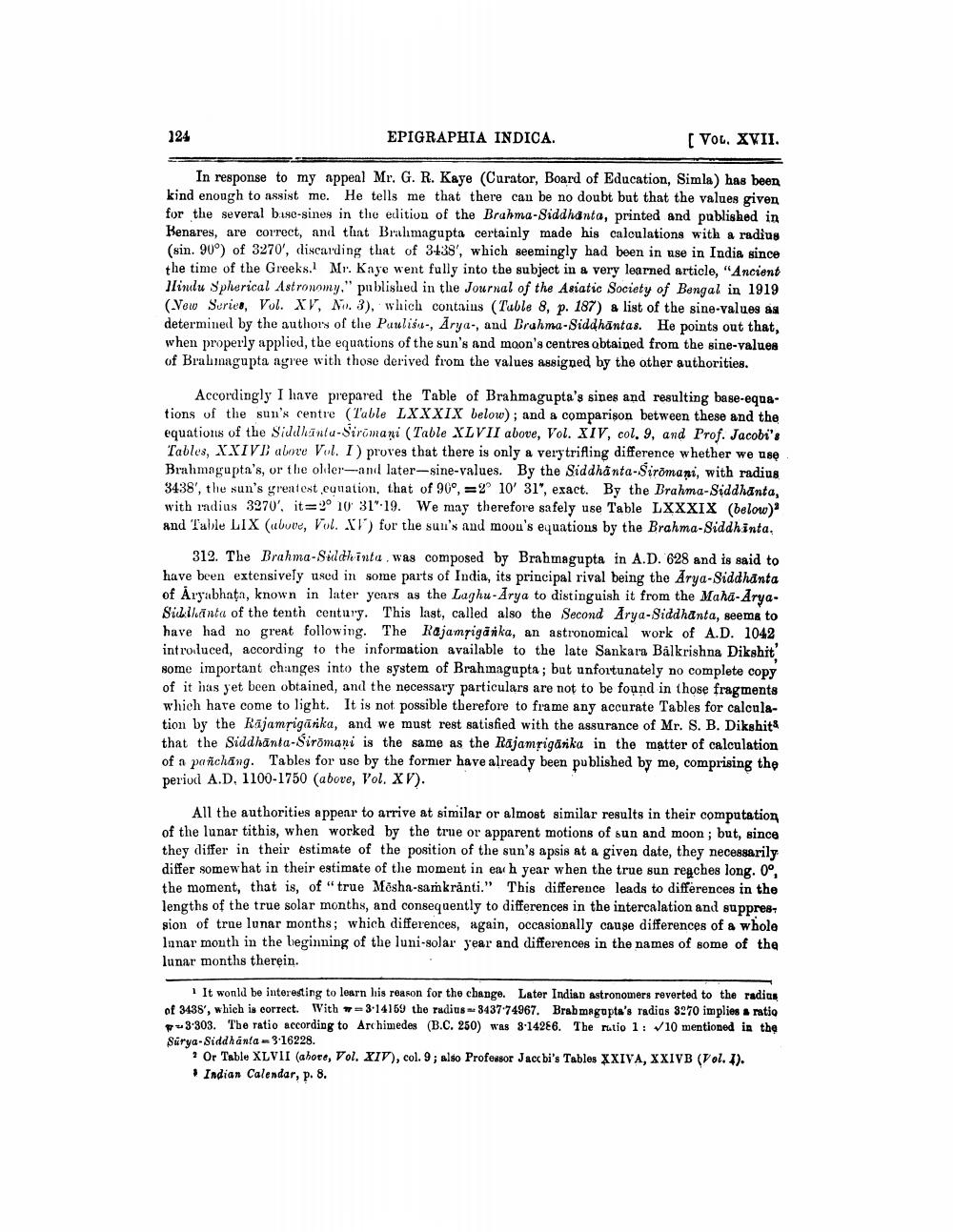________________
124
EPIGRAPHIA INDICA.
[ Vou. XVII.
In response to my appeal Mr. G. R. Kaye (Curator, Board of Education, Simla) has been kind enough to assist me. He tells me that there can be no doubt but that the values given for the several buse-sines in the edition of the Brahma-Siddhanta, printed and published in Benares, are correct, and that Brahmagupta certainly made his calculations with a radius (sin. 90°) of 3270', discarding that of 3+38', which seemingly had been in use in India since the time of the Greeks. Mr. Kaye went fully into the subject in a very learned article, "Ancient llinulu Spherical Astronomy," published in the Journal of the Asiatic Society of Bengal in 1919 (New Suries, Vol. XV, N. 3), which contains (Table 8, p. 187) a list of the sine-values as determined by the authors of the Puulisu., Arya-, and Brahma-Siddhantas. He points out that, when properly applied, the equations of the sun's and moon's centres obtained from the sine-values of Brahmagupta agree with those derived from the values assigned by the other authorities.
Accordingly I have prepared the Table of Brahmagupta's sines and resulting base-equations of the sun's centre (Table LXXXIX below), and a comparison between these and the equations of the Siddhantu-Siromani (Table XLVII above, Vol. XIV, col. 9, and Prof. Jacobi's Tables, XXIV1) above Vol. I) proves that there is only a verytrifling difference whether we use Brahmogupta's, or the older--and later-sine-values. By the Siddhanta-Siromani, with radius 3438', the sun's greatest.euuation, that of 90°, 2° 10' 31", exact. By the Brahma-Siddhanta, with indius 3270', it :) 10 31":19. We may therefore safely use Table LXXXIX (below) and Table LIX (ubuve, Vol. II) for the sun's and moon's equations by the Brahma-Siddhinta.
312. The Brahma-Siddhinta was composed by Brahmagupta in A.D. 628 and is said to have been extensively used in some parts of India, its principal rival being the Arya-Siddhanta of Aryabhata, known in later years as the Laghu-Arya to distinguish it from the Maha-AryaSilinta of the tenth century. This last, called also the Second Arya-Siddhanta, seems to have had no great following. The Rajampiganka, an astronomical work of A.D. 1042 introluced, according to the information available to the late Sankara Balkrishna Dikshit some important changes into the system of Brahmagupta ; but unfortunately no complete copy of it has yet been obtained, and the necessary particulars are not to be found in those fragments which have come to light. It is not possible therefore to frame any accurate Tables for calculation by the Rajamrigātika, and we must rest satisfied with the assurance of Mr. S. B. Dikshits that the Siddhanta-Siromani is the same as the Rājamrigărika in the matter of calculation of a pañchăng. Tables for use by the former have already been published by me, comprising the period A.D. 1100-1750 (above, Vol. XV).
All the authorities appear to arrive at similar or almost similar results in their computation of the lunar tithis, when worked by the true or apparent motions of sun and moon; but, since they differ in their estimate of the position of the sun's apsis at a given date, they necessarily differ somewhat in their estimate of the moment in ear h year when the true sun regches long. 0°, the moment, that is, of "true Mēsha-samkranti." This difference leads to differences in the lengths of the true solar months, and consequently to differences in the intercalation and suppres, sion of true lunar months; which differences, again, occasionally cause differences of a whole lanar month in the beginning of the luni-solar year and differences in the names of some of the lunar months therein.
It wonld be interesting to learn his reason for the change. Later Indian astronomers reverted to the radios of 3438', which is correct. With = 3.14159 the radius=3437-74967. Brab magupta's radias 3270 implies & ratio F-3-303. The ratio according to Archimedes (B.C. 250) was 8-14256. The ratio 1: 710 mentioned in the Sürya-Siddhanta - 3:16228.
? Or Table XLVII (ahore, Vol. XIV), col. 9; also Professor Jac bi's Tables XXIVA, XXIVB (Vol. 1).
Indian Calendar, p. 8.




